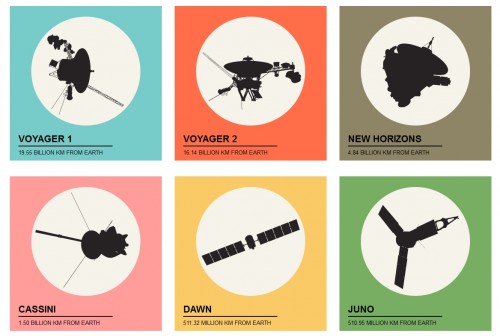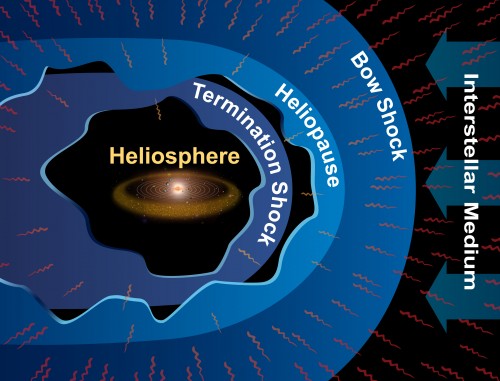Tag archives: space
Physics World 2015 Focus on Astronomy and Space is out now
By Louise Mayor
 Woolly hats are being donned and there’s a nip in the air as the longest night of the year in the Northern hemisphere approaches. All this darkness makes it the perfect season to gaze up at the stars, planets and puffy nebulae above. But binoculars and amateur telescopes can only enhance the view by so much. To really push the boundaries of how far and how fine we can see, we must turn to international telescope projects both on the ground and in space.
Woolly hats are being donned and there’s a nip in the air as the longest night of the year in the Northern hemisphere approaches. All this darkness makes it the perfect season to gaze up at the stars, planets and puffy nebulae above. But binoculars and amateur telescopes can only enhance the view by so much. To really push the boundaries of how far and how fine we can see, we must turn to international telescope projects both on the ground and in space.
To update you on what we think are the most exciting current and future projects we bring you the Physics World Focus on Astronomy and Space, which you can read free of charge in its entirety.
One particularly ambitious imaging effort is described in the article “Portrait of a black hole“, in which Physics World reporter Tushna Commissariat reports on how a group of astronomers plans to take the first-ever image of a black hole. Despite their name, black holes are apparently not black and the Event Horizon Telescope collaboration has already begun pointing a network of ground-based telescopes at its target: Sagittarius A*, the supermassive black hole at the centre of our galaxy.
View all posts by this author | View this author's profile
Heavy-metal Higgs, meet the Publons, Stephen Hawking’s galactic tour and more
By Tushna Commissariat and Hamish Johnston
I’m sure that most of you have wondered what the Higgs boson would sound like if it were a heavy-metal song. Now you can turn it up to 11 (TeV that is) courtesy of CERN physicist and guitarist Piotr Traczyk, who has “sonified” data from two plots from the CMS experiment that were presented at the Higgs discovery seminar on 4 July 2012. His heavy-metal ditty is based on gamma–gamma and 4-lepton data from CMS and after you listen to his excellent song in the above video, you can find out more about how it was created by reading this entry by Traczyk on the Cylindrical Onion blog.
View all posts by this author | View this author's profile
A journal for brief ideas, Heisenberg’s mirror, space-mission stickers and more

Mission accomplished: these graphics were created by Ariel Waldman and Lisa Ballard. (Courtesy: spaceprob.es)
By Hamish Johnston
“Dr Heisenberg’s Magic Mirror of Uncertainty” is the name of a series of photographs taken in 1999 by the American photographer Duane Michals. The picture over at that link is lovely, but I don’t really see the connection to quantum mechanics. I suspect my artist friends would accuse me of being a scientific literalist, which doesn’t bother me one bit.
More to my liking are the graphics pictured above, which have been created by Ariel Waldman and Lisa Ballard. The pair run a website called spaceprob.es, which “catalogues the active human-made machines that freckle our solar system and dot our galaxy”. Here is their page on Voyager 2, which is packed with facts about the mission’s instruments and many accomplishments. These and other illustrations of space missions can be bought as stickers and posters – the perfect gift for the space enthusiast in your life.
Flying high in Baltimore
By Susan Curtis in Baltimore, US
After two days of getting to grips with biophysics – see here and here for my experiences – I was ready for a change of scene. And a visit to the Space Telescope Science Institute (STScI), co-located with the Johns Hopkins University in Baltimore but operated on behalf of NASA, was just what I needed.
The STScI is home to many of the scientists and engineers who made the Hubble Space Telescope possible, and who have been working for many years to design the optics and instrumentation for its successor – the James Webb Space Telescope (JWST), which is due to be launched in 2018. The institute also runs the science operations for Hubble and soon will for the JWST, providing software tools for astronomers to make their observations and processing the raw data acquired by the onboard instruments to make it ready for scientific analysis.
Slamming physics at Fermilab, dancing to Yuri Gagarin and lifting off from ‘Cape Kebaberal’
By Hamish Johnston
Giving a fired-up talk at a physics conference is a good way for aspiring researchers to make themselves known to the community, but unless you have a natural gift, lots of practice is required. That’s why many universities and labs host “slams” to encourage staff and students to talk about their research to a broader audience. Above is a video of the sold-out Fermilab Physics Slam 2014, which was held last week at the lab on the outskirts of Chicago.
View all posts by this author | View this author's profile
Space bonanza to land in Manchester

The Age of Starlight will catch both the eyes and the minds of the audience. (Courtesy: ESO/P D Barthel)
By James Dacey
Whatever punters make of the Manchester International Festival (MIF) next year, they certainly won’t be able to accuse it of thinking small. Among the first commissions announced today is a “world-first show about the origin of the universe and everything within and without it”.
The Age of Starlight will be presented by the physicist and TV personality Brian Cox, who will tell the story of the unlikely events that have led to our existence. Details of the show are still scarce but we do know that the space bonanza will feature computer-generated imagery created by the Oscar-winner Tim Webber and the special-effects team behind the film Gravity. The event will be brought to life with technologies developed by Magic Leap, a Florida-based IT company that specializes in “magical” computing solutions.
View all posts by this author | View this author's profile
Candy corn in space, compact fusion reactors and physics in Palestine
By Hamish Johnston
Besides the great views of the Earth, one of the best things about being on the International Space Station (ISS) must be messing around in near-zero gravity. In the above video on Science Friday the American astronaut Don Pettit describes an “experiment” that he did on the ISS using candy corn, which are kernel-like sweets. He begins with a blob of floating water into which he inserts the candy corn pointy-end first. The points are hydrophilic so they tend to stay in the water, and eventually Pettit has a sphere of candy corn packed around the water. The flat ends of the candy corn have been soaked in oil to make them hydrophobic so the candy corn layer acts like a detergent film or one half of a cell membrane. It’s a fun video and I wonder how he got the idea in the first place?
View all posts by this author | View this author's profile
Food for Martian thought, proton role-playing in a video game and more
By Tushna Commissariat
With space agencies across the world planning manned missions to Mars in the coming decades, pondering what one would eat while on Mars seems like a sensible thing to do. SpaceX engineer Andrew Rader helps us out with this difficult question in the video above, sharing gems like “chickens can’t swallow in space.” In the video, titled “Cooking on Mars” Rader cooks and eats a seemingly unappetizing option – bugs and insects – and makes it clear that is the fare future astronauts will be partaking in.
View all posts by this author | View this author's profile
Yeah but no but yeah but no but…

The various regions at the edge of the solar system. (Courtesy: Southwest Research Institute)
By Matin Durrani
Has the Voyager spacecraft left the solar system and entered interstellar space? I don’t know about you, but I’m getting a teensy weensy bit bored by this question, which has been going on for years now.
Last September, we blogged about a paper in Science that, yep, it had definitely left the solar system a year before – on 25 August 2012 in fact.
Previous to that, though, there had been other reports that no it hadn’t (June 2013), it really, definitely is getting near the edge, but hang on actually not yet (March 2013), we’re not quite sure (June 2011), of course it’s definitely heading for interstellar space (November 2009), it’s already right near the edge (or possibly not) (November 2003).
View all posts by this author | View this author's profile
Meeting the last man to walk on the Moon

Eugene Cernan speaking at Sheffield Doc/Fest.
By James Dacey, reporting from Sheffield
“I wanted to make a film about an old space cowboy” is how British director Mark Craig introduced his new film on Sunday afternoon here at Sheffield Doc/Fest. The Last Man on the Moon takes a fresh look at the the Apollo era through the story of Eugene Cernan, who was the last person to set foot on the lunar surface when he did so in 1972 as commander of Apollo 17.
The documentary interleaves a profile of “Gene” Cernan with NASA archive footage and special effects, focusing on the personal stories of the astronauts and their families. To give you a flavour, the film opens in the present day with close-ups of Cernan’s facial reactions at a rodeo event as he admires the spectacle and the bravery of the men being thrown around on the back of bulls. Later in the film, Cernan recounts his experiences of being rotated rapidly in space during the Gemini 9A and Apollo 10 missions.
Immediately after the showing, Cernan and Craig stayed for a Q&A session and the audience gave an extended standing ovation as the 80-year-old astronaut walked to the front of the auditorium. I was fortunate to catch up with the pair this morning to get some insights into the inspiration for the film and how it was adapted from the book Cernan co-authored in 1999.
View all posts by this author | View this author's profile